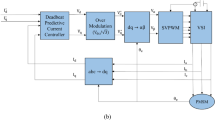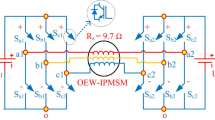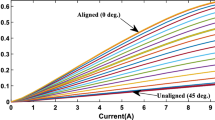Abstract
A new induction motor (IM) rotor resistance estimator based on a perturbation-based extremum seeking control (ESC) is proposed. Since implementations of field-oriented control requires accurate values of IM parameters, such as rotor time constant, so, accurate and robust on-line estimations of such parameters are crucial for any modern industrial IM drives. Since dither signal frequency has significant effect on transient response and convergence time, so, selection of this frequency is a big challenge in accurate and fast parameter estimation. A comparison has been made to show the effect of dither signal frequency in parameter identification transient and convergence time. Meanwhile, since extremum seeking control is a model-free approach, so, it is robust against other induction motor parameter variations. The feasibility and effectiveness of the IM rotor time constant estimation by using ESC scheme have been verified by simulation and experimental results. A 2.2 kW experimental prototype has been implemented.












Similar content being viewed by others
References
Kojabadi HM, Abarzadeh M, Chang L (2015) A comparative study of various methods of IM's rotor resistance estimation. In: Proceedings of ECCE, pp 2884–2891
HM Kojabadi C Liuchen R Doraiswami 2005 A MRAS-based adaptive pseudoreduced-order flux observer for sensorless induction motor drives IEEE Trans Power Electron 20 4 930 938
S Yang D Ding X Li Z Xie X Zhang L Chang 2017 A novel online parameter estimation method for indirect field oriented induction motor drives IEEE Trans Energy Convers 32 4 1562 1573
MW Degner JM Guerrero F Briz 2006 Slip-gain estimation in field-orientation-controlled induction machines using the system transient response IEEE Trans Ind Appl 42 3 702 711
JC Moreira TA Lipo 1993 A new method for rotor time constant tuning in indirect field oriented control IEEE Trans Power Electron 8 4 626 631
S Wade W Dunnigan BW Williams 1997 A new method of rotor resistance estimation for vector-controlled induction machines IEEE Trans Ind Electron 44 2 247 257
Rehman HU, Derdiyok A, Guven MK, Longya X (2001) An MRAS scheme for on-line rotor resistance adaptation of an induction machine. In: 2001 IEEE 32nd annual power electronics Specialists conference (IEEE cat. no. 01CH37230), vol 2, pp 817–822
M Barut R Demir E Zerdali R Inan 2012 Real-time implementation of bi input-extended Kalman filter-based estimator for speed-sensorless control of induction motors IEEE Trans Ind Electron 59 11 4197 4206
S Maiti C Chakraborty Y Hori MC Ta 2008 Model reference adaptive controller-based rotor resistance and speed estimation techniques for vector controlled induction motor drive utilizing reactive power IEEE Trans Ind Electron 55 2 594 601
AVR Teja V Verma C Chakraborty 2015 A new formulation of reactive-power-based model reference adaptive system for sensorless induction motor drive IEEE Trans Ind Electron 62 11 6797 6808
LJ Garces 1980 Parameter adaption for the speed-controlled static ac drive with a squirrel-cage induction motor IEEE Trans Ind Appl IA-16 2 173 178
Dybkowski M, Antoni Bednar S (2019) Simultaneous estimation of the stator and rotor resistances in an induction motor drive using novel active and reactive power based model reference adaptive system. In: Proceedings of EDPE, pp 149–154
M Haring E Skjong TA Johansen M Molinas 2018 Extremum-seeking control for harmonic mitigation in electrical grids of marine vessels IEEE Trans Ind Electron 35 1 1
Letchindjio CGF, Dewasme L, Vande Wouwer A (2019) Extemum seeking for micro-algae biomass biomass productivity maximization: an experimental validation. In: Proceedings of IFAC, 52, pp 281–286
Leblanc M (1922) “Sur l’´ electrification des chemins de fer au moyen de courants alternatifs de fr´ equence ´ elev´ ee,” Revue G´ en´ erale de l’Electricit´ e
M Krstic 2000 Performance improvement and limitation in extremum seeking control Syst Control Lett 39 5 313 326
Guay M, Dhaliwal S, Dochain D (2013) A time-varying extremum seeking control approach. In: American control conference (ACC), June 2013, pp 2643–2648
Guay M, Burns DJ (2014) A comparison of extremum seeking algorithms applied to vapor compression system optimization. In: American control conference (ACC)
MH Mahmud Y Wu Y Zhao 2019 Extremum seeking based optimum reference flux searching for direct torque control of interior permanent magnet synchronous motors IEEE Trans Transp Electrif 6 1 11
Ermilina OV, Mikhliov PG, Semenov AD, Sokolov AV (2020) Extremum seeking of asynchronous electric drive with frequency current regulation. In: Proceedings of the 2020 Moscow workshop on electronic and networking technologies (MWENT)
Kamal NA, Ibrahim AM (2018) Conventional, intelligent, and fractional-order control method for maximum power point tracking of a photovoltaic system: a review. Fract Order Syst
R Lyva C Alonso 2006 MPPT of photovoltaic systems using extremum—seeking control IEEE Trans Aerosp Electron Syst 42 1 249 258
U Ciri MA Rotea S Leonardi 2017 Model-free control of wind farms: a comparative s tudy between individual and coordinated extremum seeking Renew Energy 113 1033 1045
KB Ariyur M Kristic 2003 SISO scheme and linear analysis: real time optimization by extremum seeking control Wiley New York
R Marino S Peresada P Tomei 2000 On-line stator and rotor resistance estimation for induction motors IEEE Trans Control Syst Technol 8 3 570 579
M Wang D Wang G Dong H Wei X Liang Z Xu 2019 Simplified rotor and stator resistance estimation method based on direct rotor flux identification J Power Electron 19 3 751 760
Author information
Authors and Affiliations
Corresponding author
Additional information
Publisher's Note
Springer Nature remains neutral with regard to jurisdictional claims in published maps and institutional affiliations.
Rights and permissions
Springer Nature or its licensor (e.g. a society or other partner) holds exclusive rights to this article under a publishing agreement with the author(s) or other rightsholder(s); author self-archiving of the accepted manuscript version of this article is solely governed by the terms of such publishing agreement and applicable law.
About this article
Cite this article
Madadi Kojabadi, H. Dither frequency effects on extremum seeking control-based induction motor parameter estimation. Electr Eng 105, 1555–1564 (2023). https://doi.org/10.1007/s00202-023-01755-0
Received:
Accepted:
Published:
Issue Date:
DOI: https://doi.org/10.1007/s00202-023-01755-0




